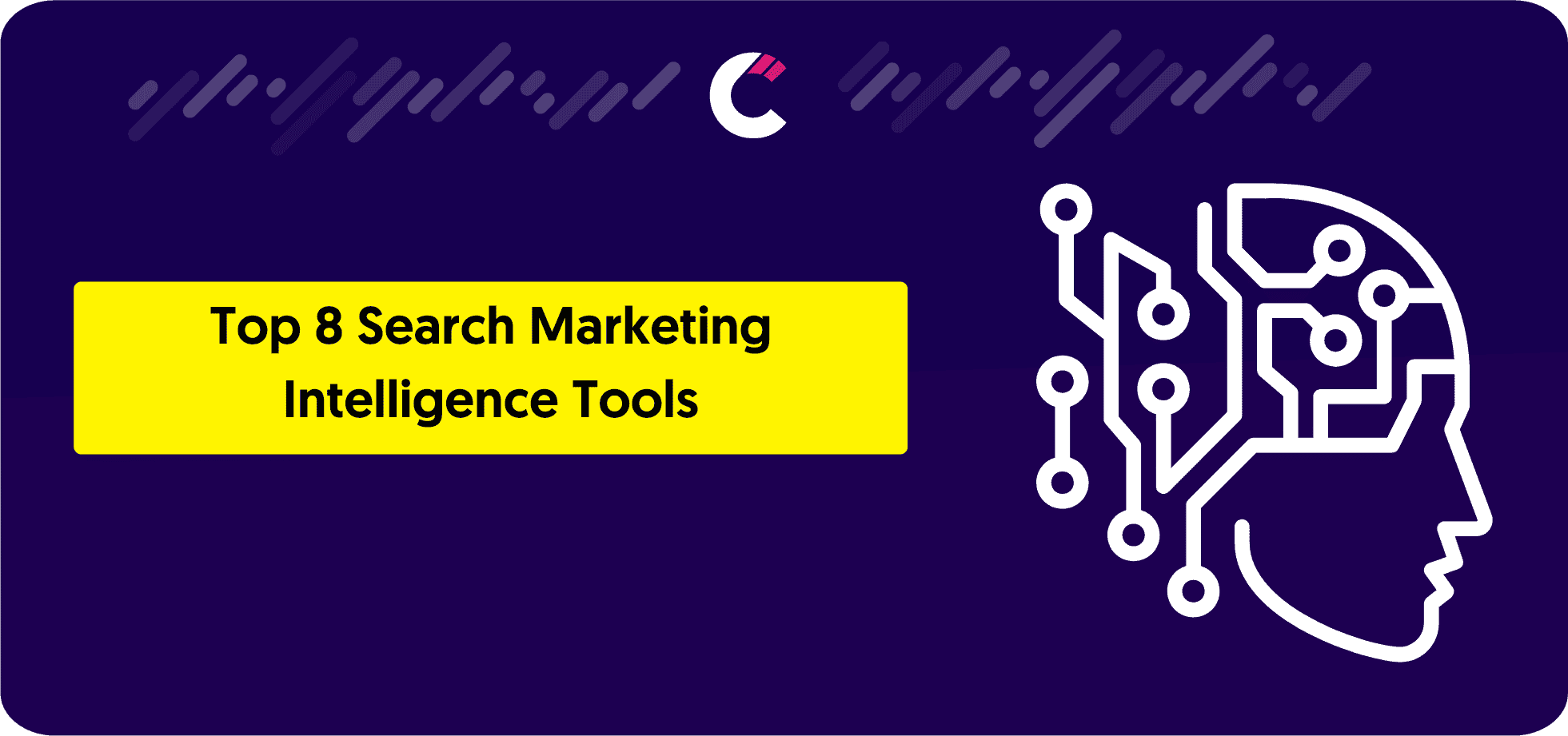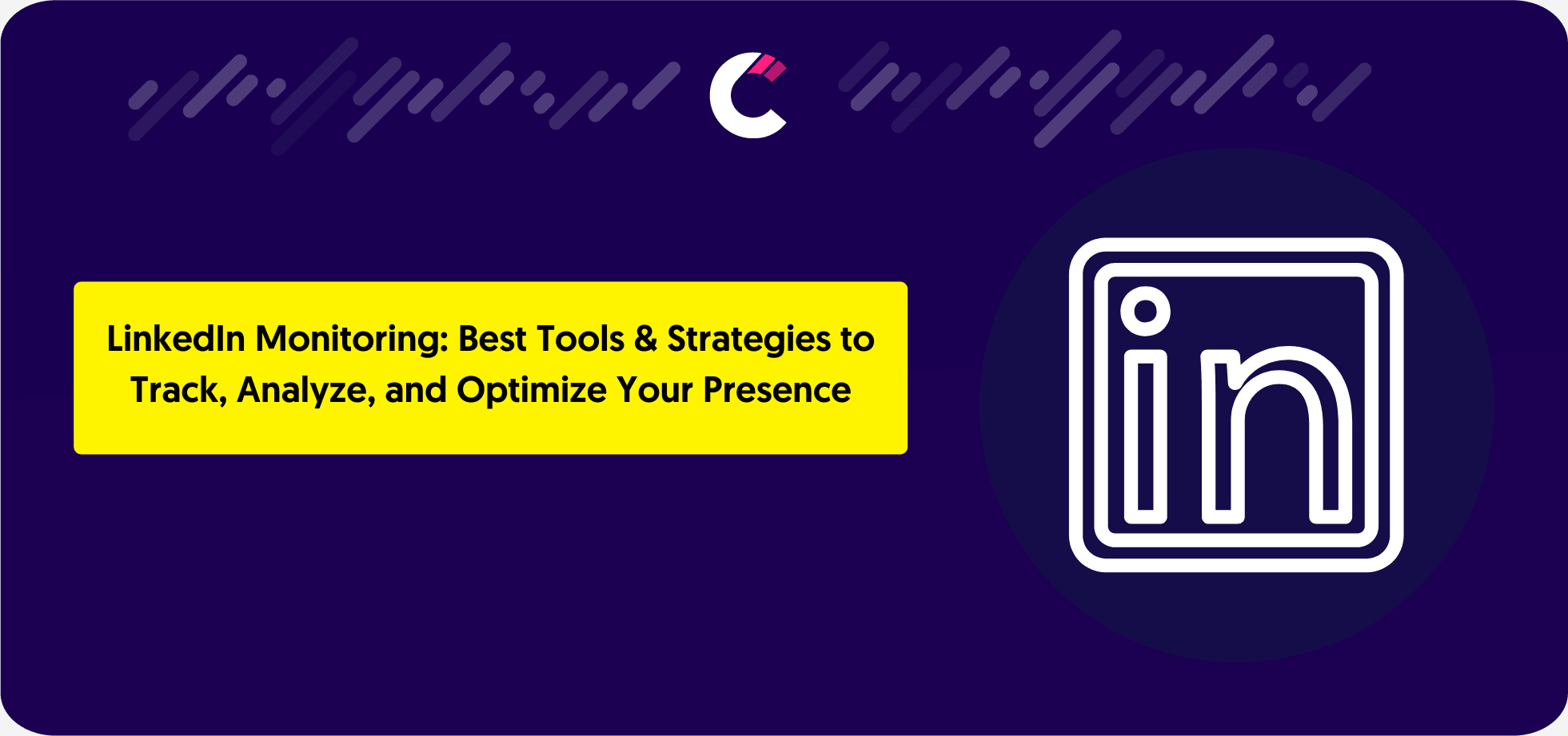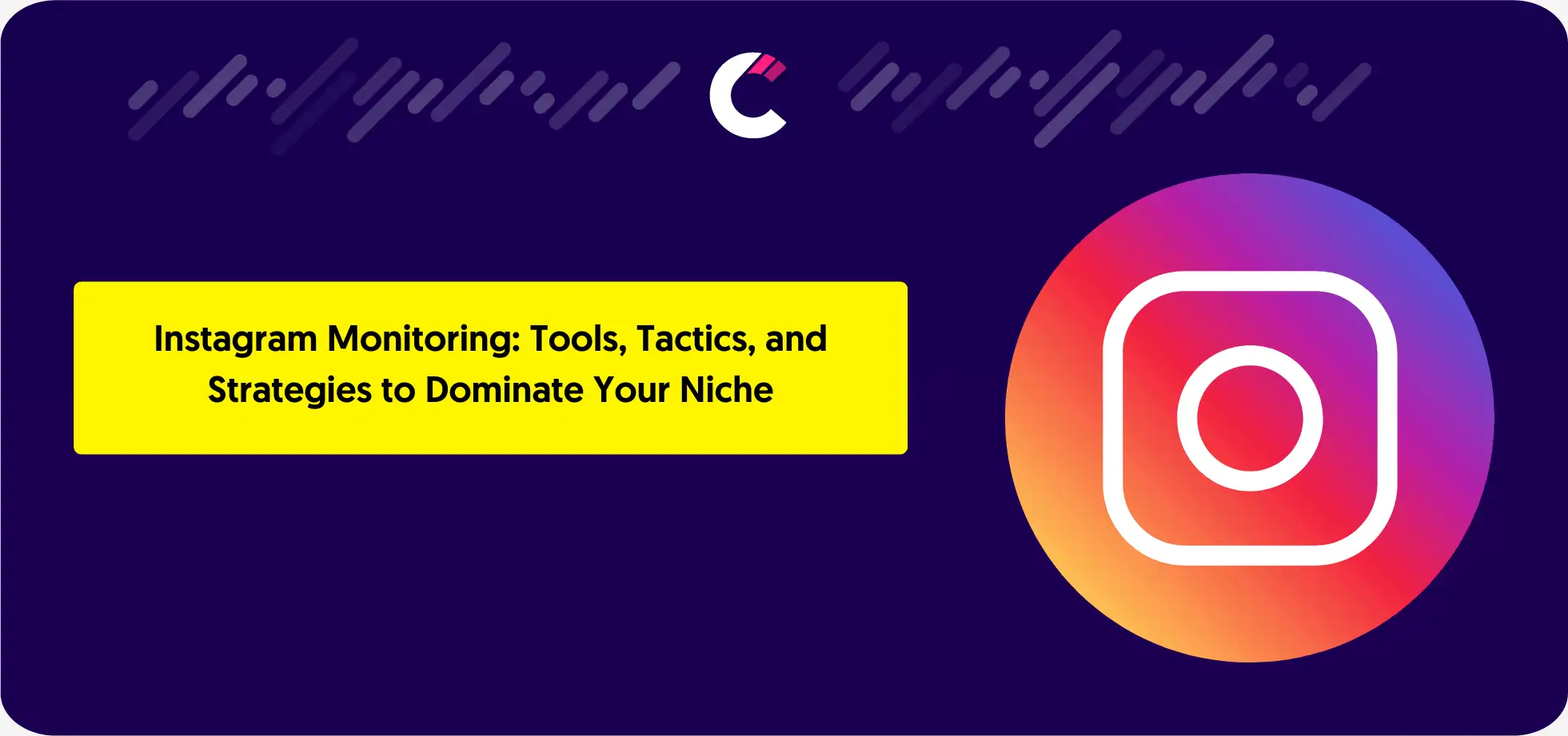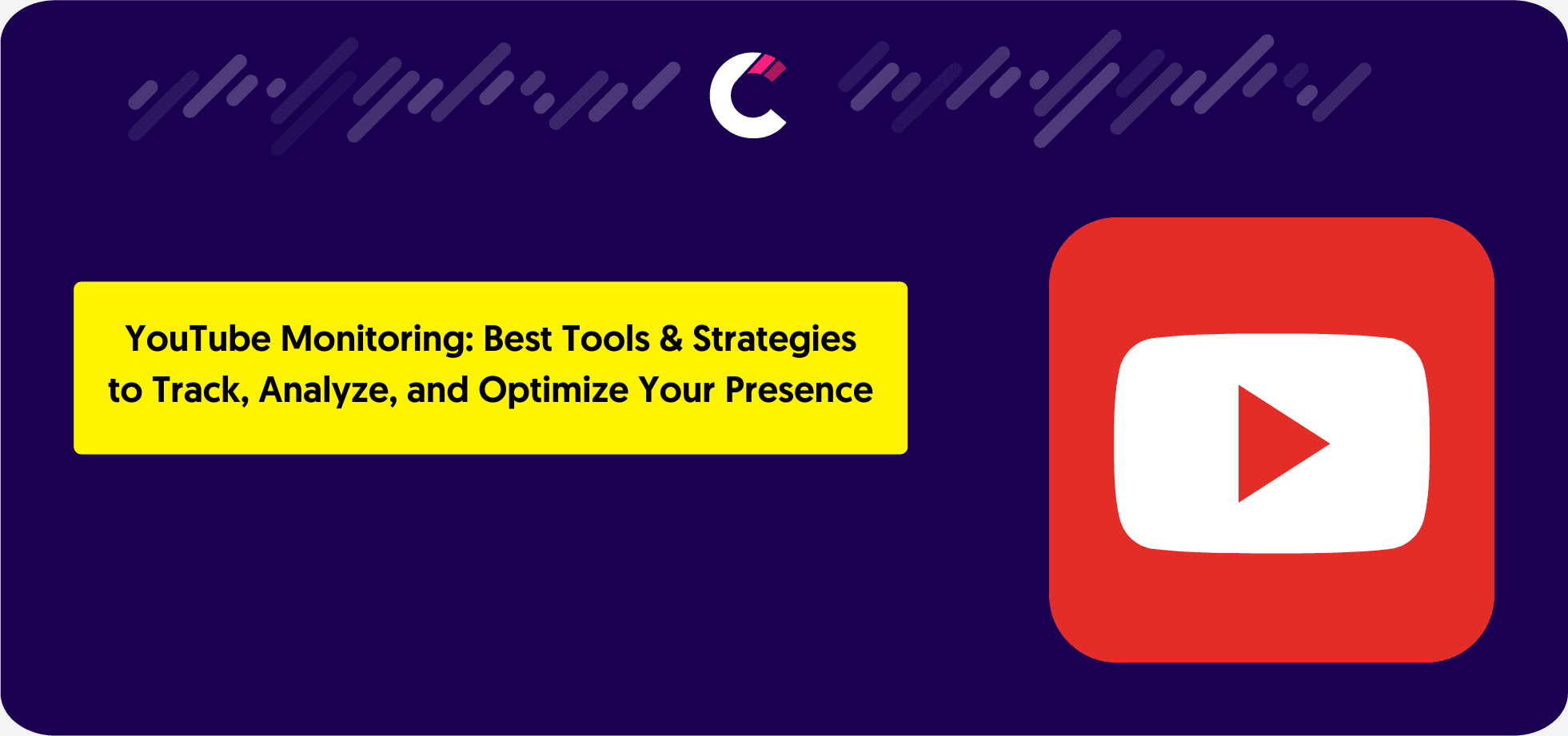Understanding the fast-evolving landscape of digital marketing requires more than just traditional tactics. *Search marketing intelligence* has become an essential tool for businesses looking to make data-driven decisions that keep them ahead in competitive online spaces.
By gathering insights from search engines about keyword trends, competitor actions, and ad performance, search marketing intelligence (SMI) gives companies the power to refine their strategies across both organic and paid search.
In this guide, we’ll explore what SMI entails, why it’s important for today’s digital strategies, and how different teams within an organization can leverage it to improve everything from brand visibility to product development.
Introduction to Search Marketing Intelligence
Search marketing intelligence (SMI) serves as a comprehensive framework that transforms raw search engine data into actionable insights, driving smarter marketing strategies. Unlike traditional search engine optimization (SEO) or pay-per-click (PPC) campaigns, SMI digs deeper by monitoring everything from keyword trends and competitive ad spend to content effectiveness.
This intelligence enables brands to adjust tactics based on real-time data, keeping them responsive to both competitors and shifting consumer interests. As search engines evolve, SMI is crucial for businesses aiming to maintain a competitive edge, helping them understand not only what users are searching for but also how rivals are positioning themselves in the market.
Key Components of Search Marketing Intelligence
The major components of search marketing intelligence provide a structured approach for collecting and analyzing data across search channels. Here’s a breakdown of each:
- SEO Intelligence
Focuses on keyword research, search volume, and ranking trends to help brands optimize their organic search visibility. It includes backlink analysis, on-page SEO insights, and other SEO-related factors that influence traffic growth.
- SERP Tracking & Analysis
Tracks a brand’s position in search engine results pages (SERPs) for key terms. This component helps brands identify changes in their ranking positions and analyze factors affecting visibility, including featured snippets and other SERP elements.
- Paid Search Intelligence
Provides insights into competitors’ paid search strategies, including ad copy, bid strategies, and ad performance data. This helps brands monitor and refine their own PPC tactics based on industry trends and competitor behavior.
- Ad Intelligence
Dives deeper into paid ad specifics, like ad placements, frequency, and creative effectiveness. By understanding how competitors position their ads, brands can craft more effective, targeted campaigns.
- Content Intelligence
Analyzes trending topics, popular content themes, and user engagement to guide content strategy. This insight helps brands create relevant, engaging content that resonates with audiences and aligns with current search trends.
- Competitor Content Analysis
Compares the effectiveness of competitors’ content to help brands identify gaps in their own approach. This component assesses engagement, content reach, and overall impact to inform more competitive content creation.
- Trend Spotting for Content Strategy
Identifies emerging industry trends and changes in consumer interest, using search and social data. This data-driven trend spotting enables brands to proactively address new topics, keeping content relevant and competitive.
Key Metrics in Search Marketing Intelligence
Effective search marketing intelligence relies on key metrics to gauge success, identify opportunities, and fine-tune strategies. Here are the most essential metrics:
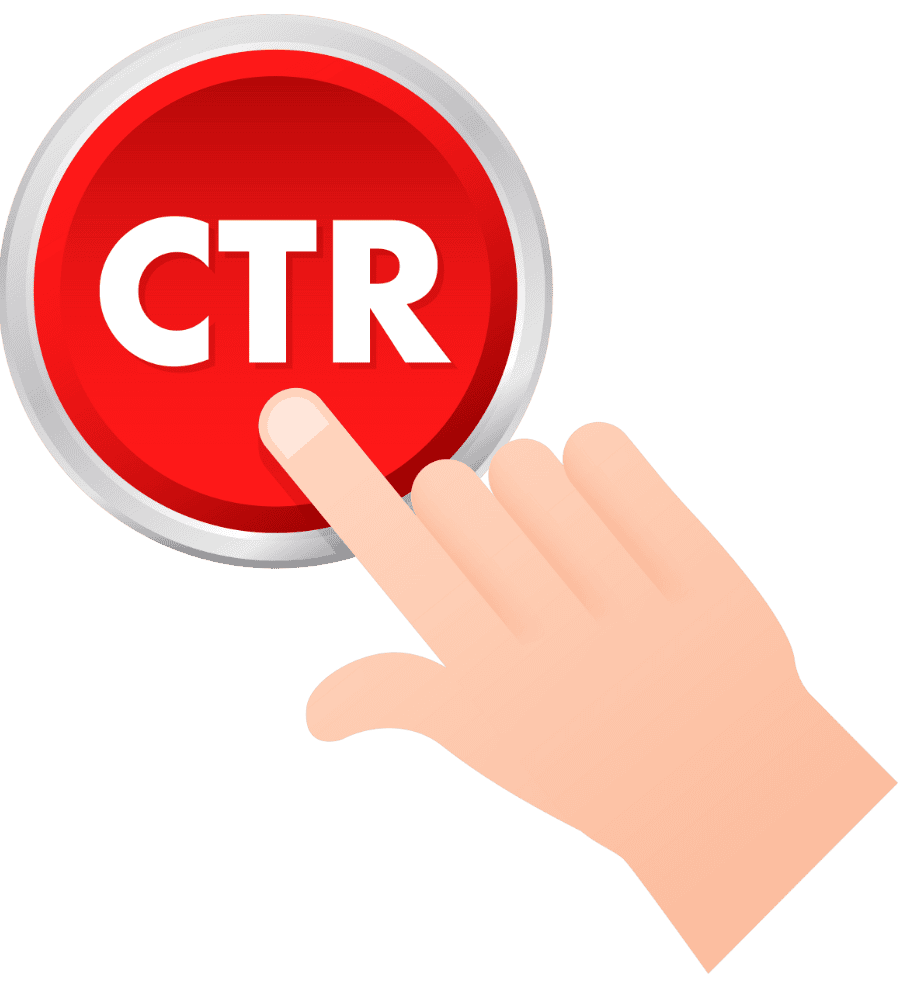
Impressions and Click-Through Rates (CTR)
Impressions measure how often a brand's content or ads appear in search results, while CTR indicates the percentage of viewers who click on those links. High impressions paired with low CTRs suggest the need for more engaging titles or descriptions.

Keyword Rankings and Movements
Tracking keyword rankings and movements over time reveals how well a brand performs in organic search. Regular ranking shifts highlight the effectiveness of SEO efforts and can help adjust strategies to maintain or improve visibility.

Competitive Share of Voice (SOV)
SOV measures the proportion of visibility a brand holds relative to competitors for targeted keywords. A higher SOV indicates greater search presence, giving a brand an edge in audience reach and authority within its market.

Ad Spend and Return on Ad Spend (ROAS)
ROAS tracks the profitability of paid search campaigns by comparing the revenue generated to the ad spend. Monitoring ROAS alongside ad spend helps brands allocate budgets effectively and maximize the returns from PPC investments.

Engagement and Sentiment Metrics
These metrics reflect how users interact with content and ads, including likes, shares, and comments. Sentiment analysis goes deeper to assess the tone of user feedback, providing insights into brand perception and content resonance.
Search Marketing Intelligence for Different Business Teams
Search marketing intelligence is valuable across various business functions, enabling teams to make data-backed decisions and align their goals. Here’s how it supports each team:
- Marketing and Sales Enablement Teams
Marketing and sales teams use SMI to pinpoint relevant keywords and optimize content that resonates with their audience, boosting lead generation and customer engagement. Access to competitive ad data and trend insights also helps refine messaging to stand out in crowded markets.
- Business Development and Strategy Teams
Strategy teams leverage competitive analysis and market trend data to shape long-term growth plans. SMI helps these teams identify emerging trends, track competitors’ strategic moves, and align the company’s goals to capitalize on new opportunities in the market.
- Data Analytics Teams
Data analytics teams use search marketing intelligence metrics to understand customer behavior, such as keyword preferences and content engagement. These insights aid in creating predictive models and optimizing future campaigns based on trends and user actions.
- Product and Account Management Teams
SMI provides product and account managers with insights into customer needs and market gaps, supporting product positioning and feature development. By understanding customer search intent and competitor offerings, these teams can adapt product roadmaps to meet evolving demands.
Top Search Marketing Intelligence Tools
Using the right tools can make all the difference in obtaining and applying search marketing intelligence effectively. Here’s a look at some of the best search marketing intelligence tools, each offering unique features and pricing to suit various needs:
Tool Name | Key Features | Advantages | Disadvantages | Pricing |
Social media and SEO monitoring, competitor ad analysis, website change alerts, and email monitoring | Affordable for smaller businesses, frequent updates | Limited advanced analytics features | ||
SimilarWeb | Traffic insights, competitor tracking, keyword gap analysis | Detailed analytics, multi-channel insights | High cost for more advanced plans | Starter at $125/month (billed annually) or $199 month-to-month; Professional at $333/month (billed annually) or $449 month-to-month; custom pricing for Team & Enterprise plans |
Ahrefs | Backlink tracking, keyword analysis, SERP monitoring | Excellent for SEO, rich backlink data | Limited paid search capabilities | Lite at $129/month; Standard at $249/month; Advanced at $449/month. |
Visualping | Website change tracking, real-time alerts | Simple setup, effective for competitor monitoring | Limited SEO insights | Starts at $10/month |
Kompyte | Competitor content tracking, social media monitoring, analytics | Advanced competitor insights, useful for larger teams | High cost for entry | Custom pricing based on features |
BuzzSumo | Content insights, social engagement tracking, influencer identification | Great for content strategy, user-friendly | Limited PPC data | Starts at $199/month |
Crayon | Comprehensive market intelligence, web and ad tracking | Robust competitor analysis | Expensive, mostly enterprise-focused | Custom pricing based on features |
AlphaSense | AI-powered trend analysis, market and competitive intelligence | Detailed insights, strong support for enterprise | High cost, geared towards large organizations | Custom pricing based on features |
1. Competitors App
Competitors App is ideal for businesses that want streamlined competitor monitoring across several key digital marketing areas. This tool offers social media monitoring, SEO and backlink tracking, website change detection, and competitor ad analysis. It’s designed to capture real-time competitor activities, including new content updates on social media or blogs and changes in SEO strategy. The tool sends customizable alerts for different competitive actions, allowing marketers to analyze trends and shifts in competitor tactics swiftly. Competitors App is especially useful for smaller businesses or those beginning to explore competitive analysis due to its affordability and accessibility.
Pricing: Starts at $19.90 per month with a 14-day free trial.
Key Features
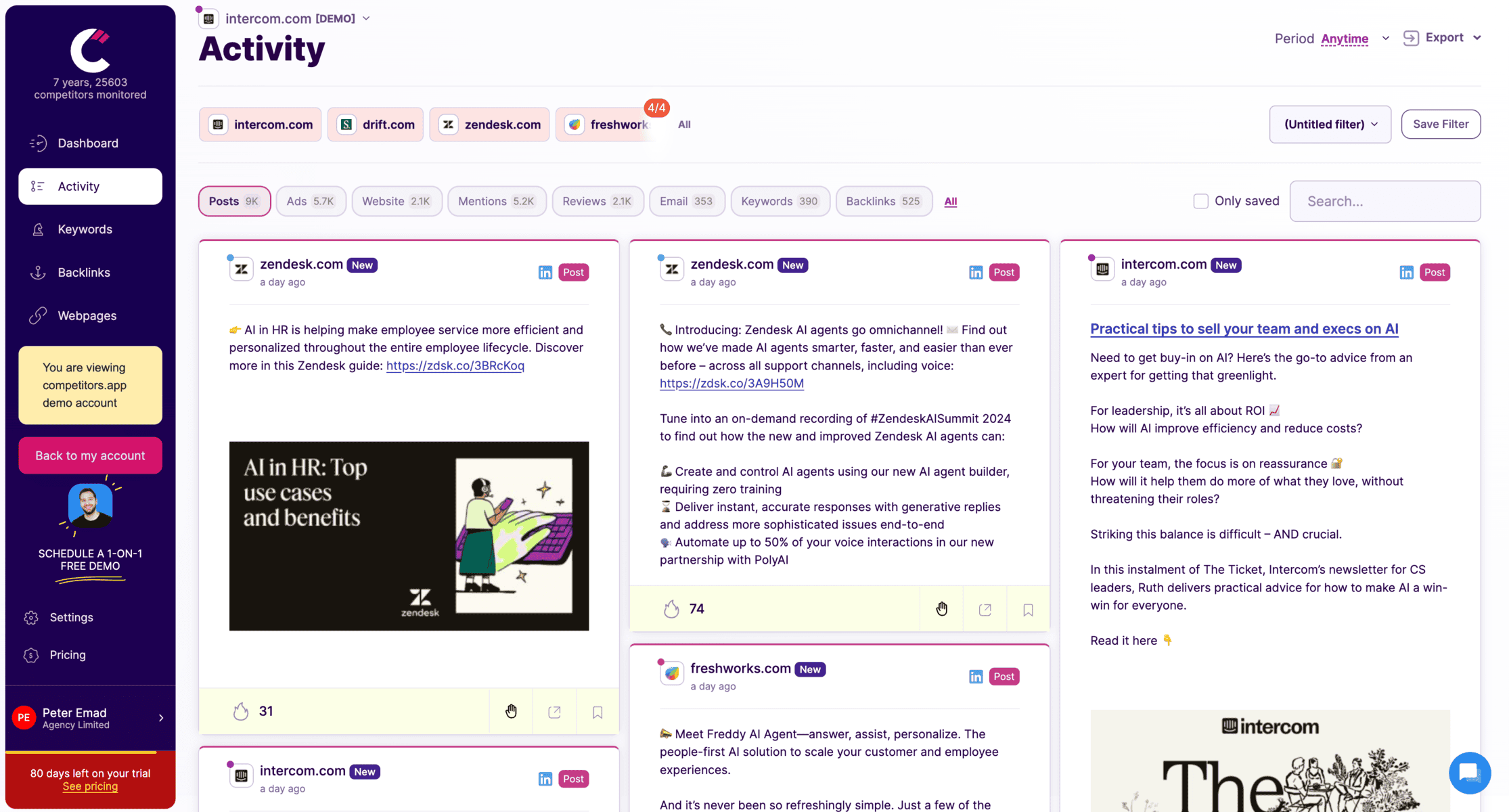
Tracks competitor social media updates across LinkedIn, Facebook, Twitter, and more.
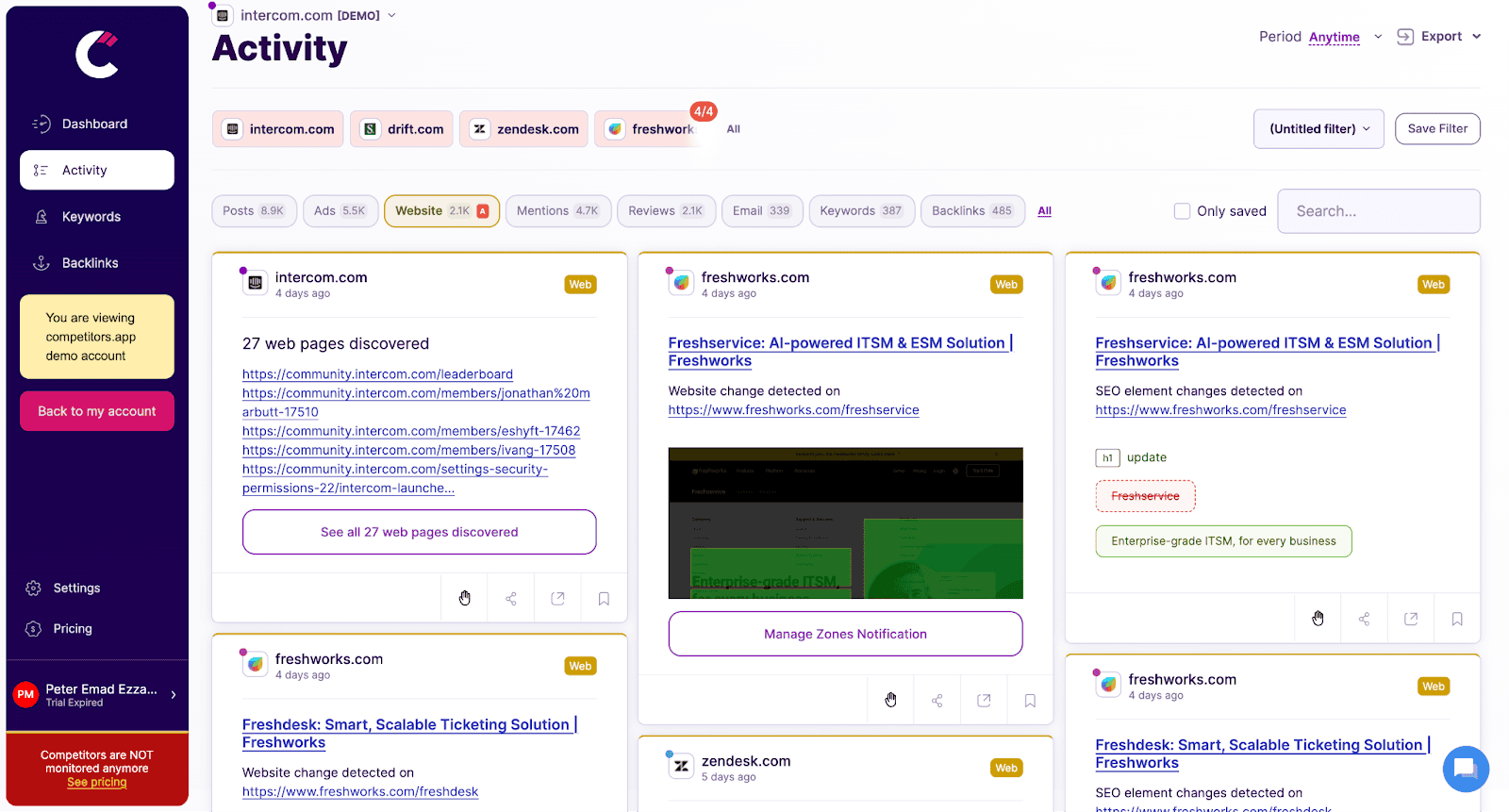
Monitors changes on competitors’ websites, such as product updates, pricing adjustments, and new messaging, providing instant alerts to help sales teams respond promptly.
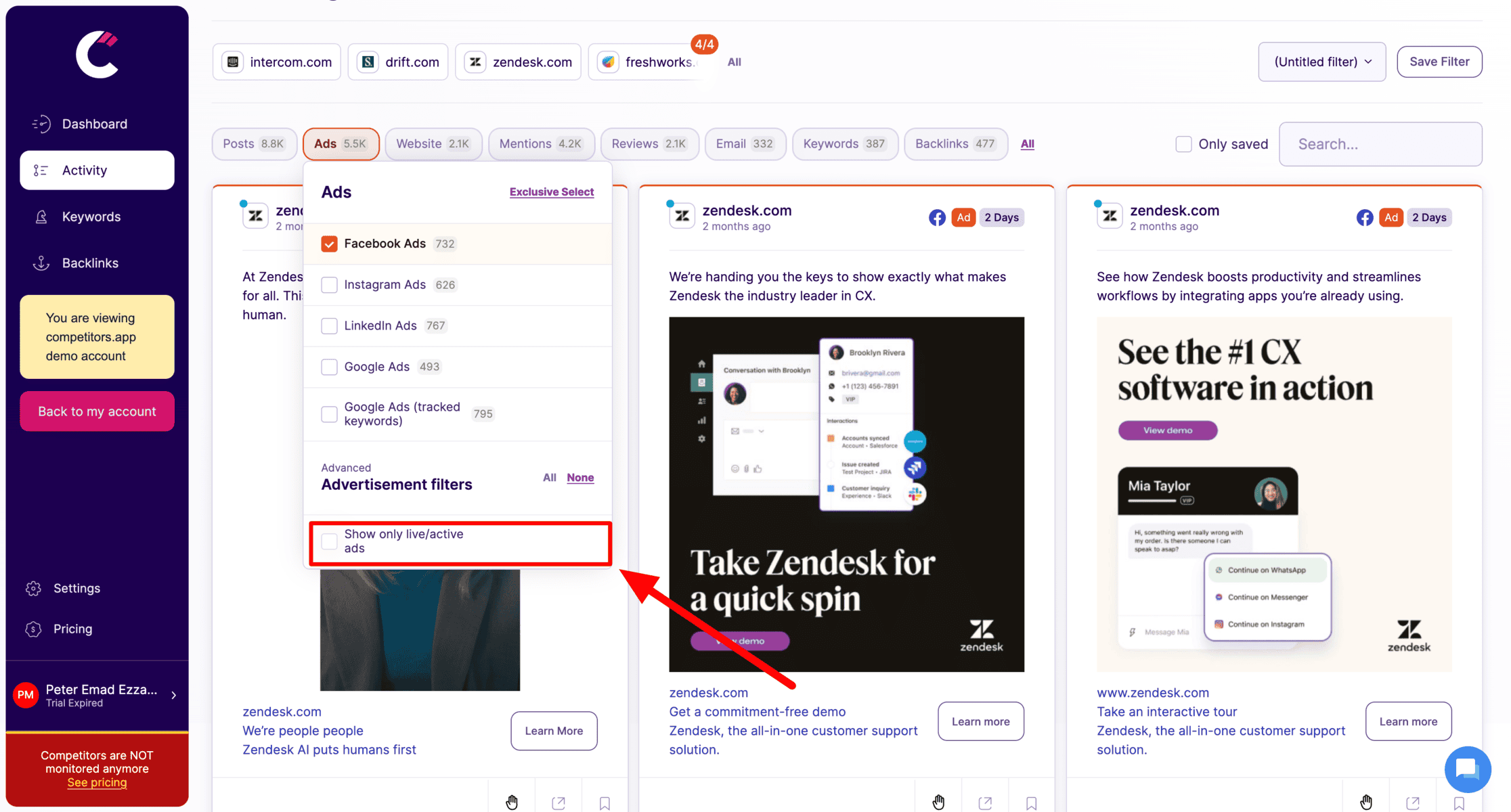
Tracks digital ad campaigns across platforms like Google Ads, Facebook, LinkedIn, and Instagram. It provides details on ad creatives, spending, and performance metrics, helping teams analyze successful ad strategies.

Analyzes competitors’ keyword strategies, organic rankings, and backlinks, allowing teams to refine their own SEO tactics and boost search visibility.

Tracks competitors’ email campaigns, including content, frequency, and engagement metrics, helping sales teams understand email tactics that drive engagement and conversions.
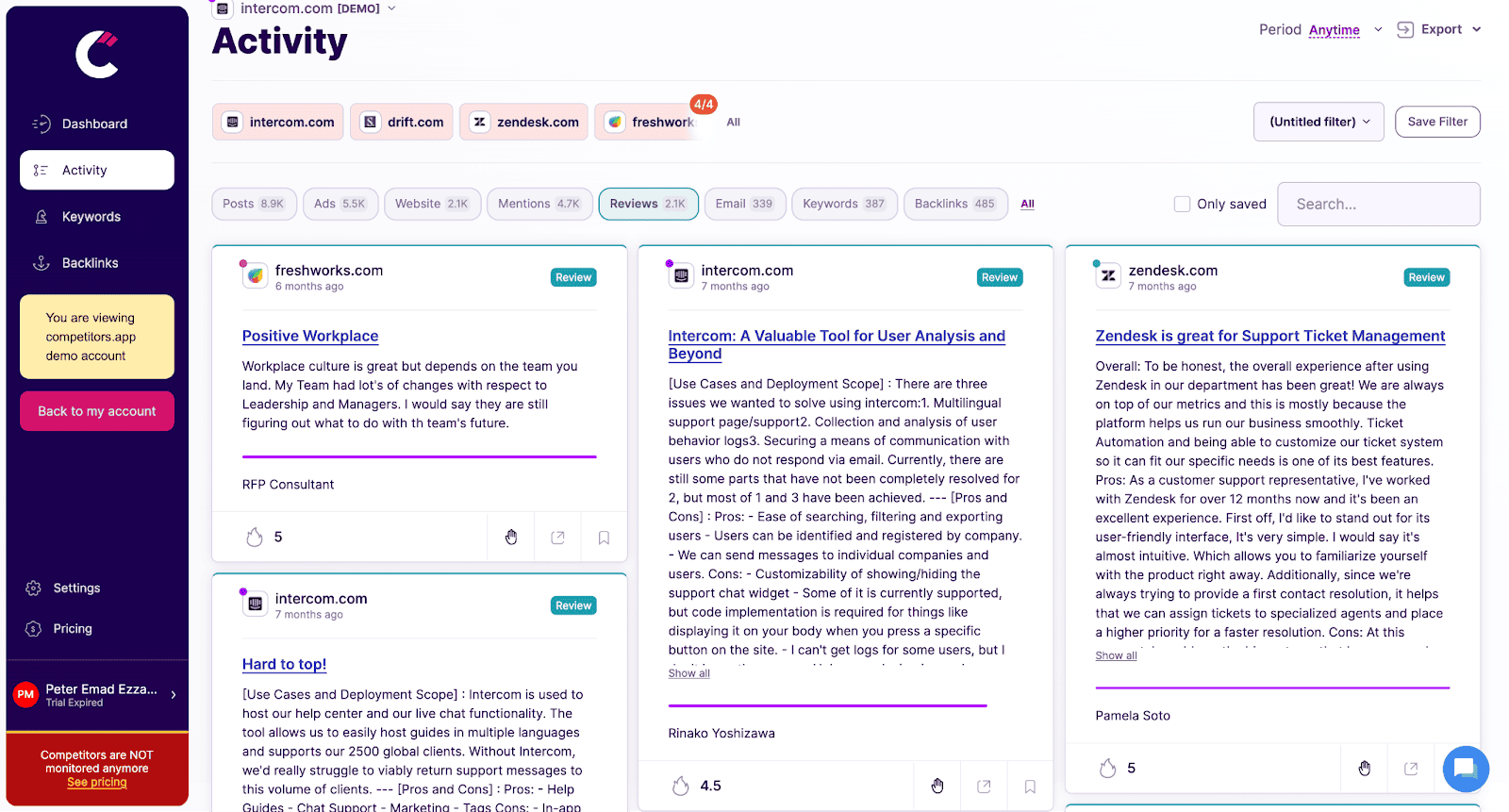
Analyzes customer reviews and ratings for competitors, providing insights into customer feedback, pain points, and product strengths, helping teams craft better sales pitches.
SimilarWeb
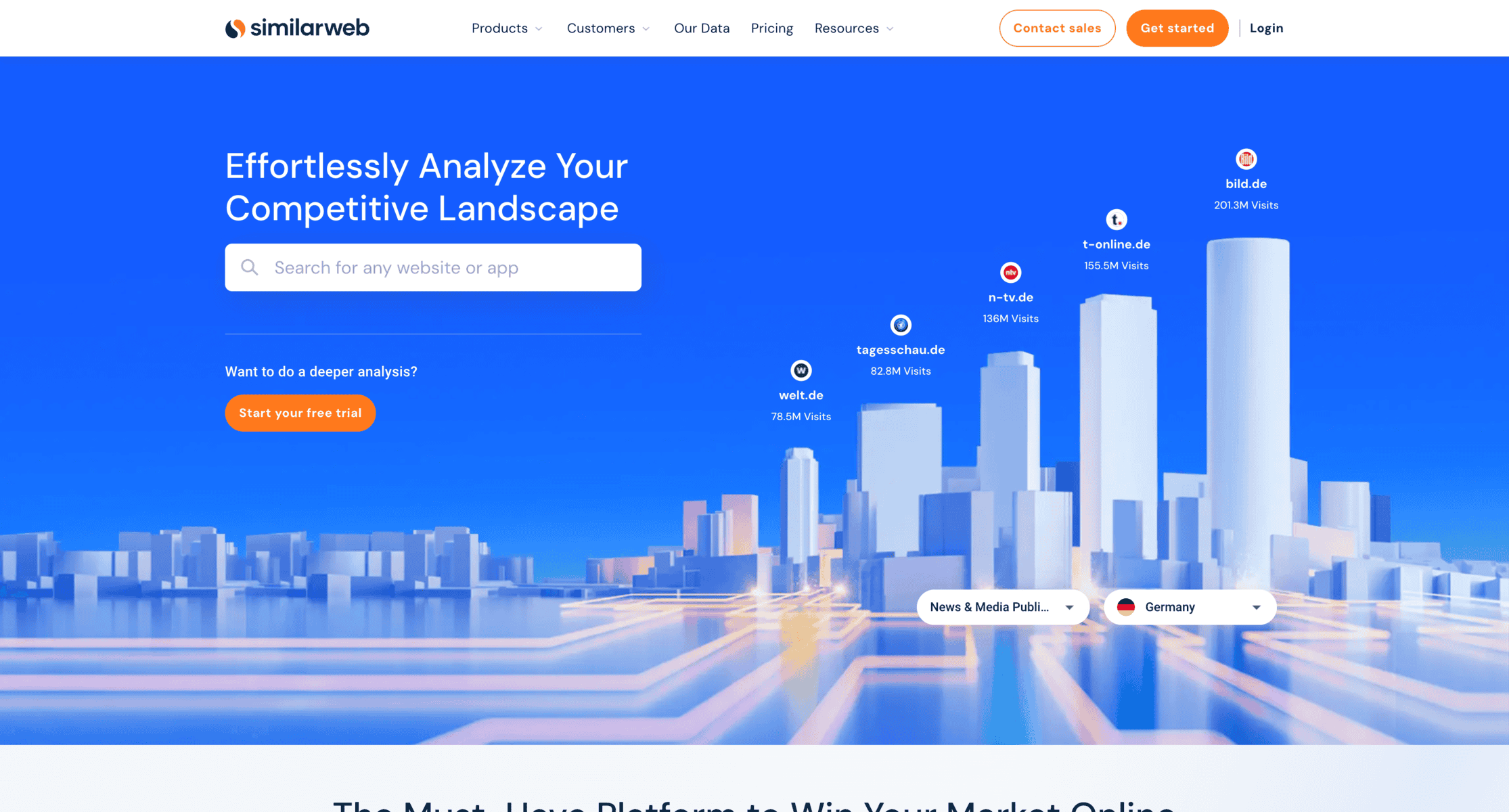
SimilarWeb provides an in-depth look at traffic sources, competitor insights, and keyword analysis. As a comprehensive market intelligence platform, it allows businesses to analyze traffic trends, audience demographics, and competitor benchmarks across multiple digital channels, including web and mobile. SimilarWeb’s tools for keyword gap analysis and traffic insights make it invaluable for SEO and content strategists aiming to identify new opportunities and threats. This platform also helps in tracking referral sources, audience behavior, and site performance, offering a big-picture view of the digital landscape.
Pricing: Starts at $125/month (billed annually) for the Starter plan, with more advanced Professional and Enterprise plans priced higher.
Ahrefs
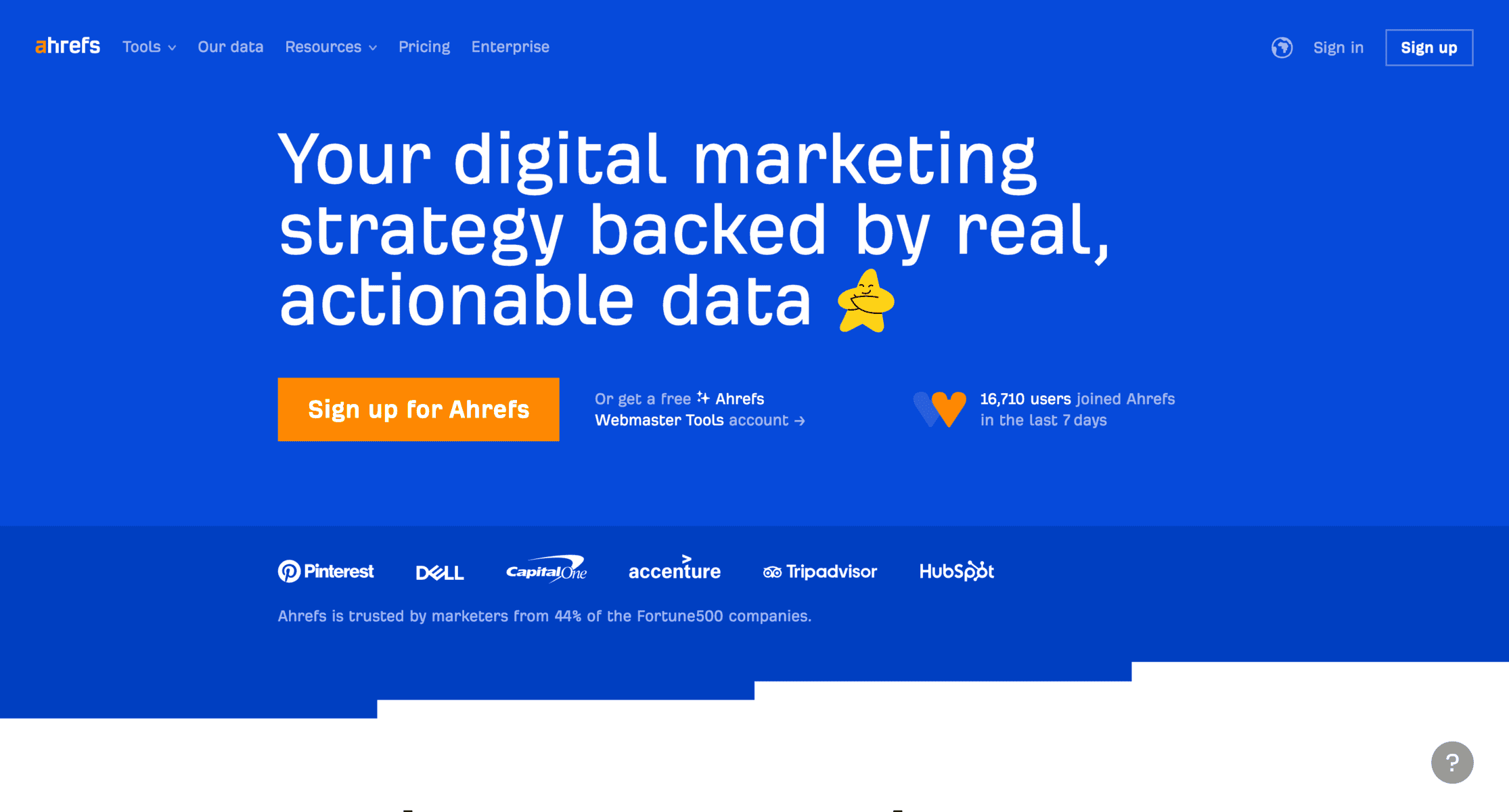
Ahrefs is well-regarded among SEO professionals for its backlink analysis, keyword tracking, and site audit features, making it a powerful tool for organic search strategy. Ahrefs allows users to analyze a competitor’s backlink profile in detail, check historical ranking changes, and access a broad array of keyword data. Its Content Explorer also helps identify top-performing content across various industries, which is valuable for content marketing teams looking to optimize or develop new topics. Ahrefs’ tools, like the Rank Tracker and Keywords Explorer, are easy to navigate, making it suitable for businesses of all sizes aiming to enhance their SEO efforts.
Pricing: Plans start at $129/month for Lite and $249/month for Standard.
Visualping
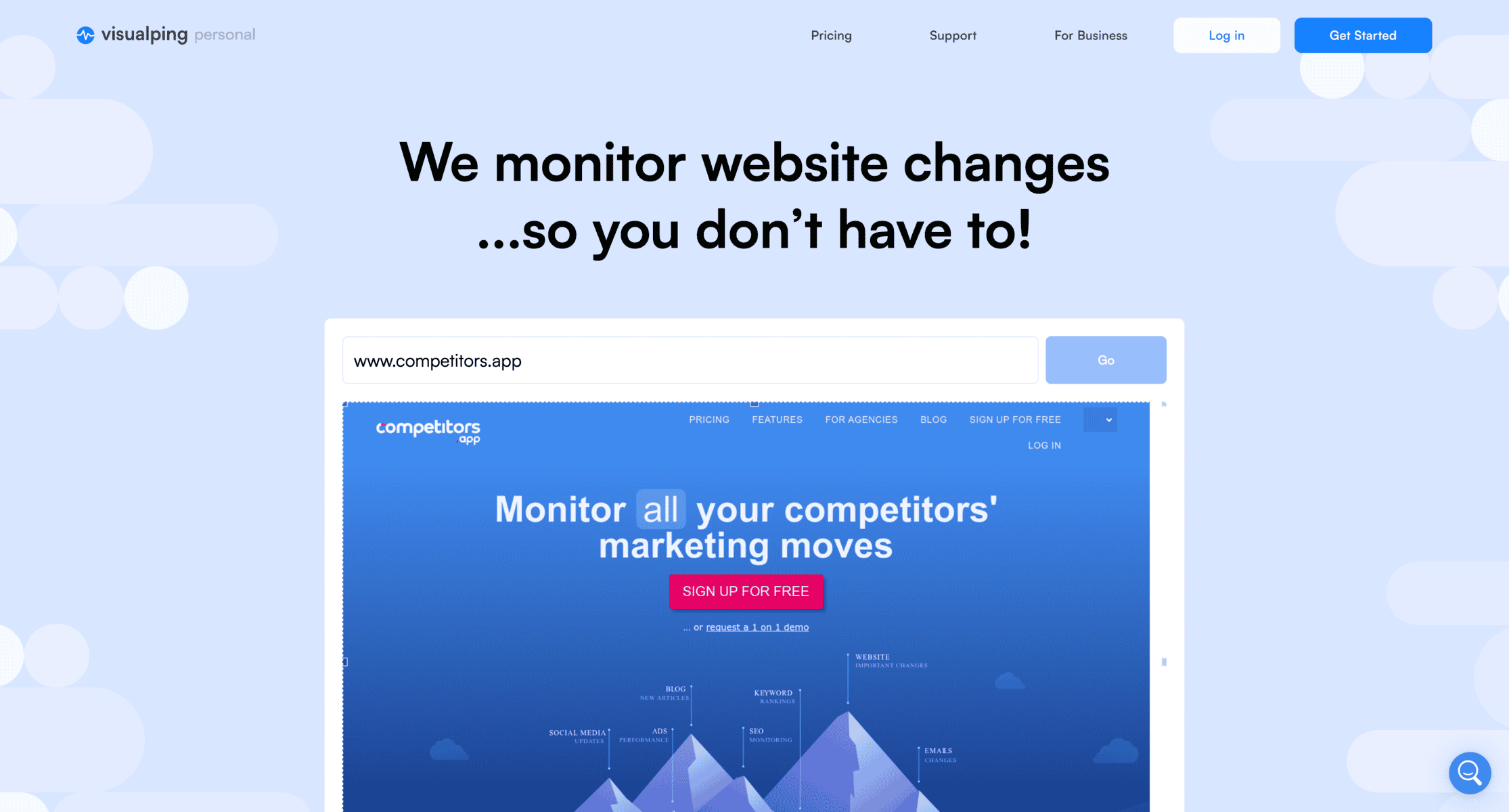
Visualping is a simple yet effective tool for monitoring website changes, primarily focusing on tracking competitor updates. With real-time alerts, Visualping notifies users whenever a competitor makes content changes to their site, such as updates to product pages or new blog posts. This can be valuable for businesses that want to respond quickly to competitors’ moves, especially in fast-paced industries. It also allows users to set up monitoring parameters to focus on specific parts of a page or certain changes only, making it highly customizable.
Pricing: Starts at $10/month.
Kompyte
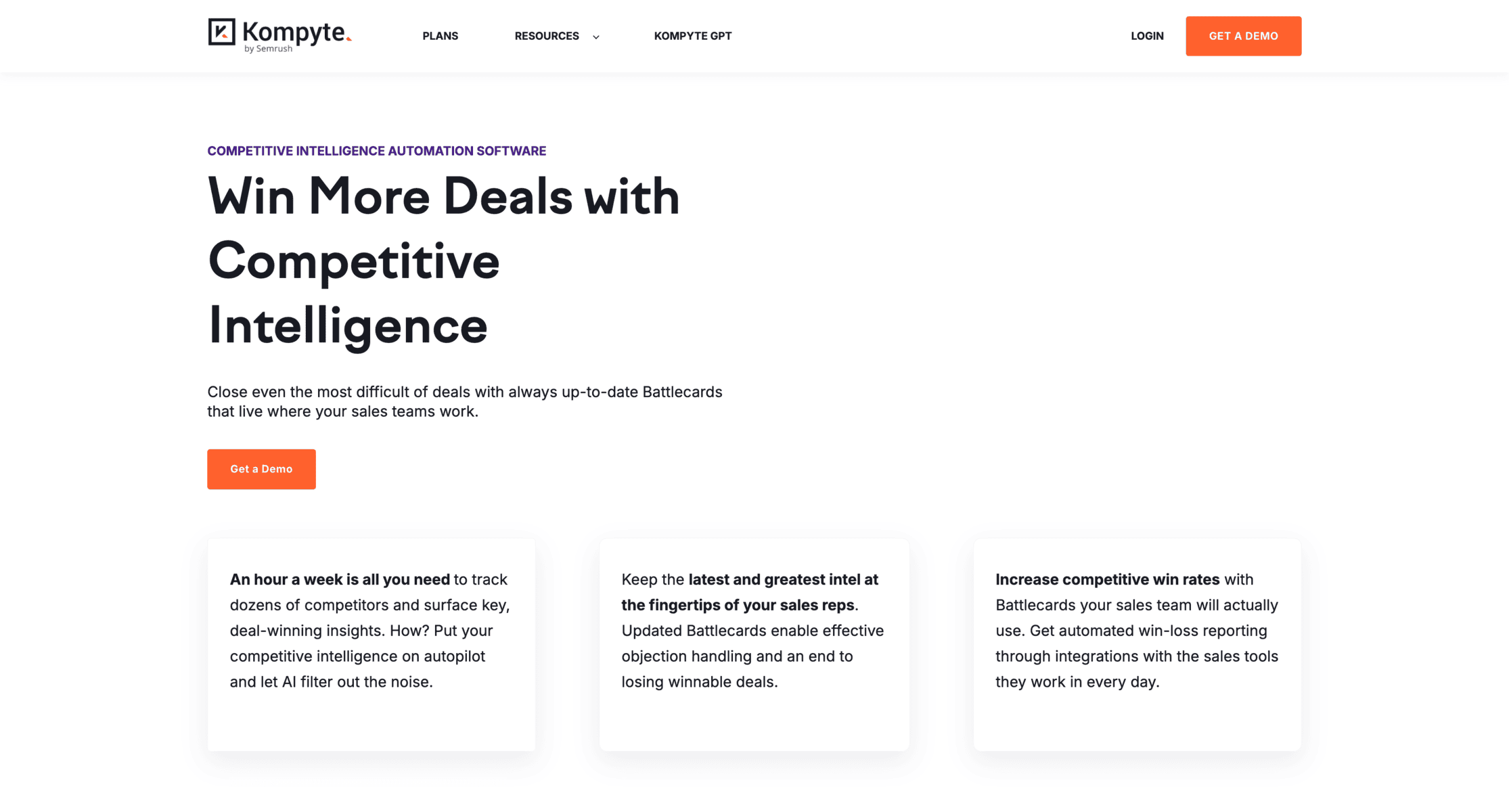
Kompyte is tailored for mid-to-large businesses looking for advanced competitive intelligence features. It offers competitor content tracking, social media monitoring, and analytics that allow teams to analyze trends, messaging, and digital strategies across channels. Kompyte provides detailed insights on competitors’ content performance and digital strategies, enabling brands to stay ahead by adapting their own approaches based on competitor moves. The platform also allows users to automate competitor tracking, making it a powerful choice for marketing teams needing continuous updates on industry changes.
Pricing: Custom pricing based on features and user requirements.
BuzzSumo
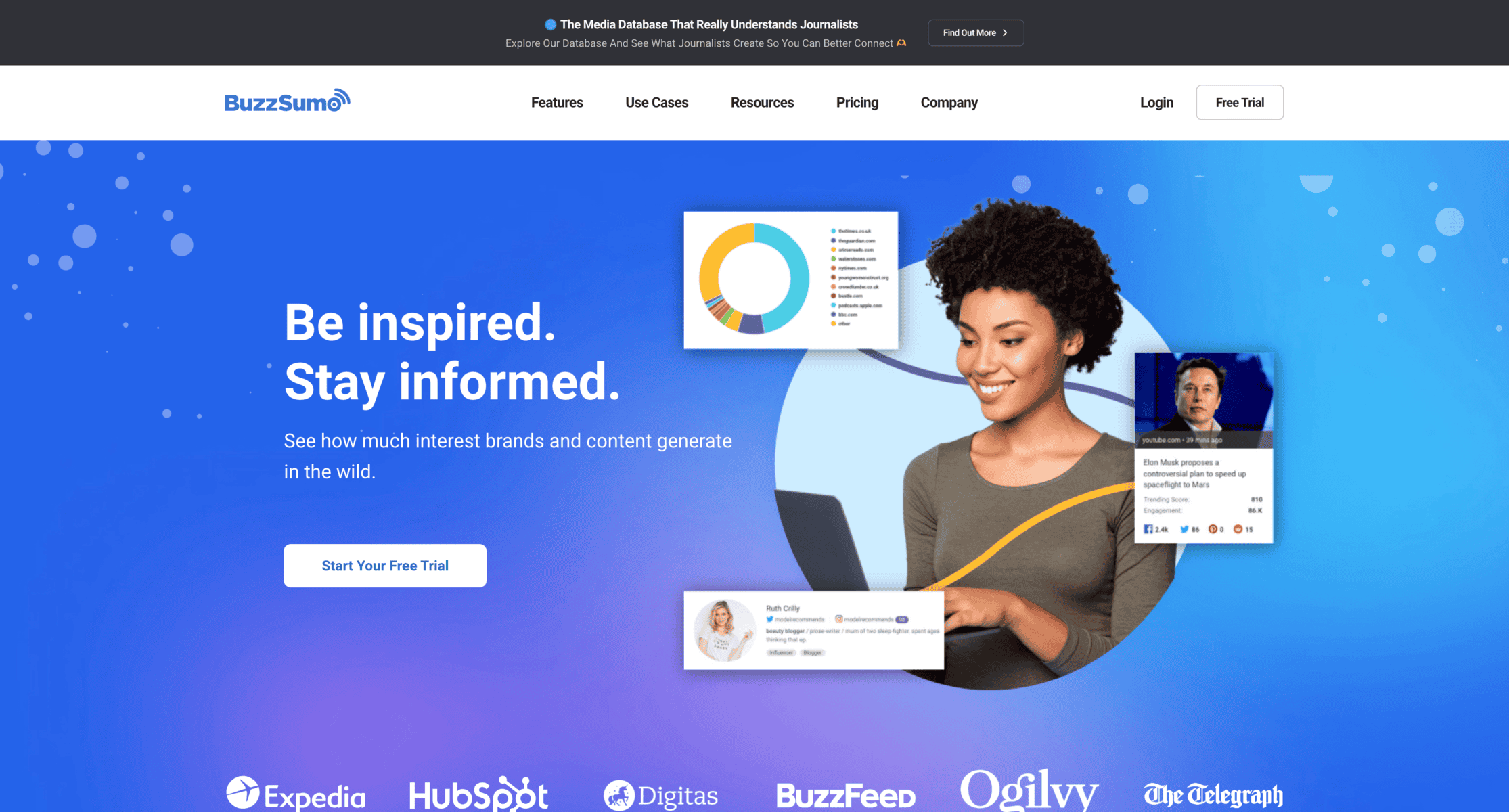
BuzzSumo is a highly effective tool for content insights, social engagement tracking, and influencer identification. It allows content and social media teams to discover popular topics and measure engagement trends across platforms, helping them craft content that resonates with target audiences. BuzzSumo’s features like Content Analyzer and Trending Now are especially beneficial for identifying high-performing content in real time, which is ideal for brands looking to build impactful and timely campaigns. Additionally, BuzzSumo’s influencer identification tools help brands collaborate with key figures in their niche.
Pricing: Starts at $199/month.
Crayon
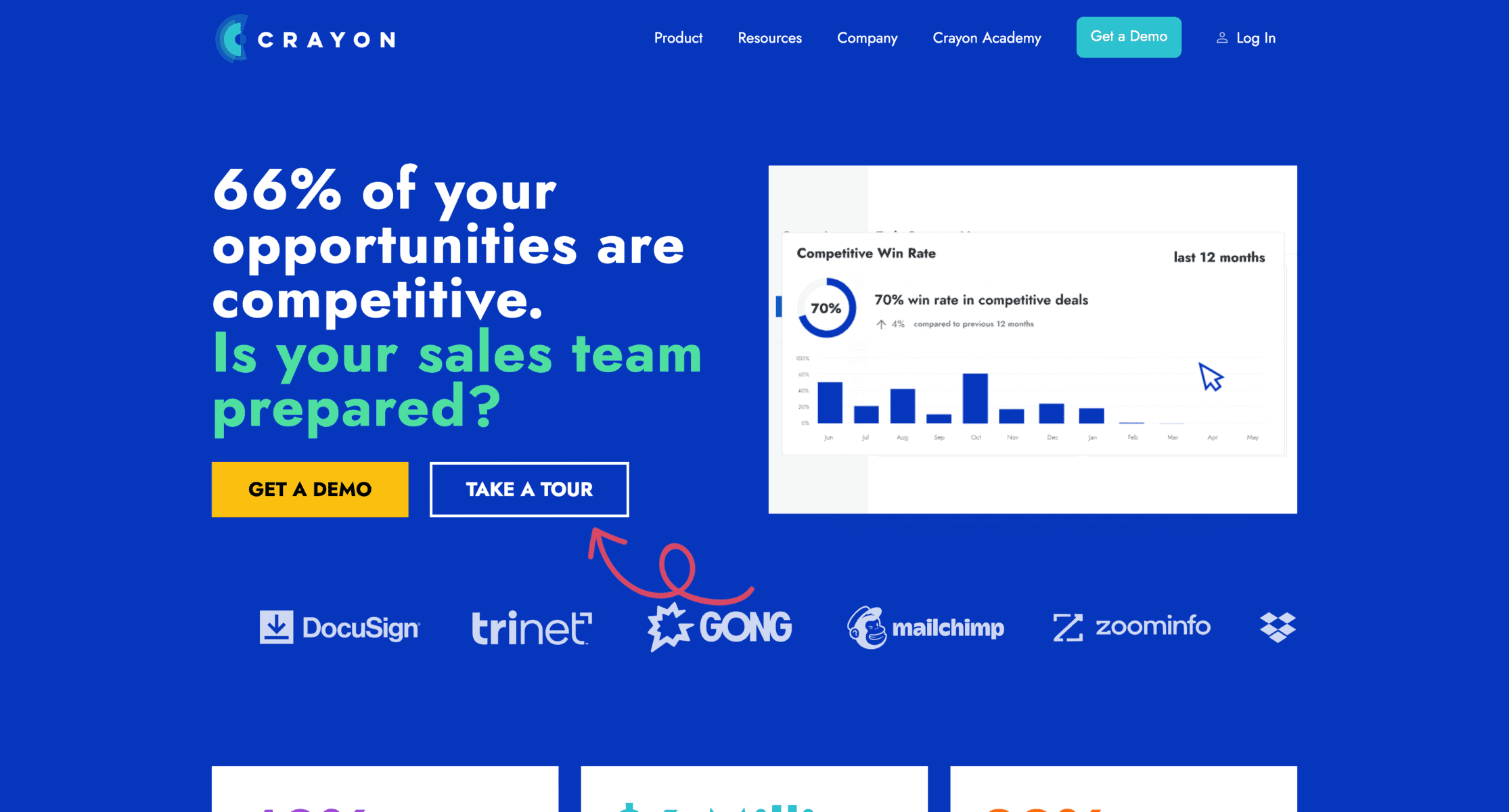
Crayon provides extensive competitive intelligence for businesses that need to monitor competitors’ digital footprints, including web updates, ad campaigns, and messaging changes. It’s known for its web change detection capabilities, which notify users of updates to competitors’ websites and marketing assets. Crayon’s in-depth tracking helps businesses understand how competitors evolve their positioning and strategy over time, making it valuable for long-term strategic planning. This tool is particularly useful for larger businesses or those in highly competitive industries.
Pricing: Custom pricing based on features and user requirements
AlphaSense
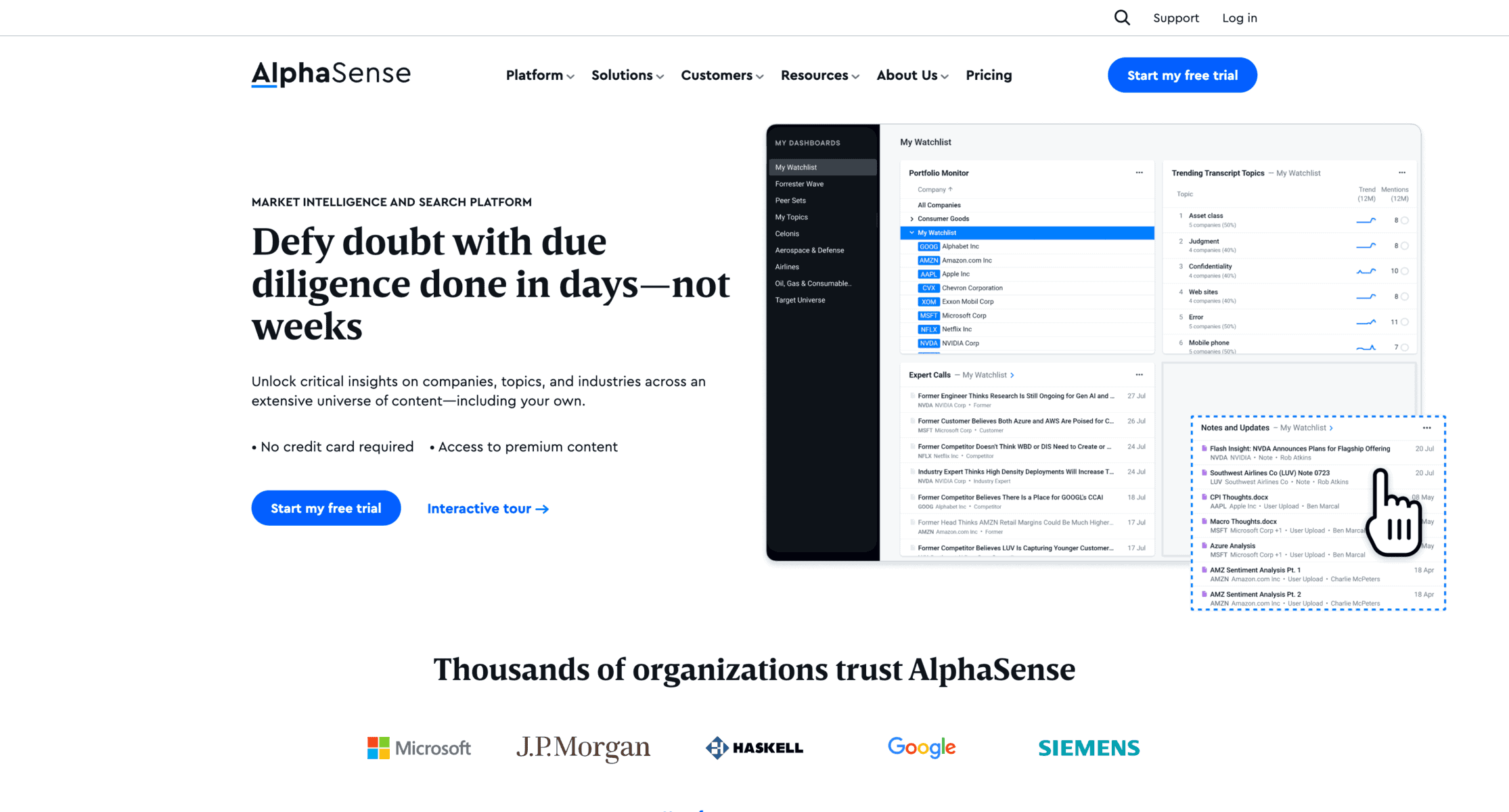
AlphaSense is designed for enterprise users who require AI-driven market intelligence and predictive analytics. This tool uses advanced algorithms to track changes in market sentiment, competitor actions, and emerging trends. AlphaSense’s platform can analyze large volumes of data and provide insights into industry shifts, regulatory changes, and competitor news, making it ideal for finance, healthcare, and other industries where market intelligence is critical. It also integrates with other business intelligence tools to offer a seamless data analysis experience.
Pricing: Custom pricing, primarily targeted toward enterprise clients.
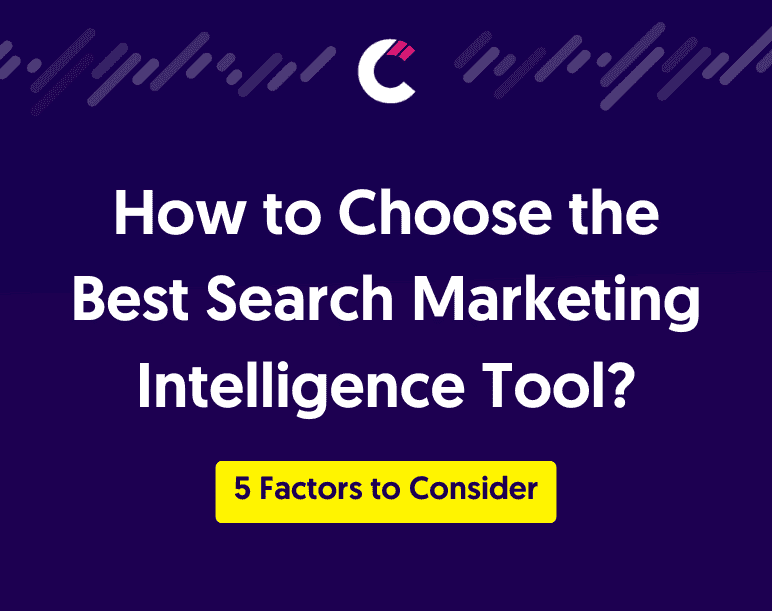
How to Choose the Best Search Marketing Intelligence Tool
Selecting the right search marketing intelligence tool depends on a brand’s specific goals, resources, and technical requirements. Here are some important factors to consider when evaluating tools:
1. Matching Tool Features to Your Goals
Different tools cater to various aspects of search marketing intelligence, from competitor tracking and content analysis to SEO monitoring and paid ad insights. Businesses with a strong focus on SEO might find Ahrefs or SimilarWeb ideal, given their powerful keyword and backlink tracking capabilities, while those focusing on social engagement and content insights might prefer BuzzSumo or Competitors App. Start by identifying your primary objectives—whether it’s tracking competitors, optimizing content, or enhancing SEO—to select the tool that aligns best with your needs.
2. Key Considerations: Pricing, Integrations, and Usability
Pricing is a critical factor, especially for businesses working within a budget. Tools like Competitors App offer cost-effective solutions starting at $19.90/month, while enterprise-level options like Crayon and AlphaSense have custom pricing structures that tend to be higher. Evaluate the cost in relation to your expected ROI from the data and insights provided. Additionally, check for integration capabilities with your existing CRM or BI tools, as seamless data integration can enhance the efficiency of intelligence analysis across teams. Finally, usability is key—platforms like Visualping and BuzzSumo are known for user-friendly interfaces, while more complex tools like SimilarWeb may require training or a learning curve.
3. Evaluating Data Accuracy and Real-Time Capabilities
Data accuracy and timeliness are essential for effective search marketing intelligence, as outdated or inaccurate data can mislead strategy decisions. Tools like Ahrefs and SimilarWeb are known for reliable, timely data on web traffic and rankings, making them suitable for businesses needing frequent updates. Tools offering real-time alerts, like Visualping and Competitors App, are valuable for keeping up with immediate competitor actions, especially in dynamic industries where swift responses matter.
4. Assessing Competitor Analysis and Ad Tracking Features
If competitor analysis is a primary focus, tools like Kompyte, SimilarWeb, and Crayon provide robust competitive insights. These tools offer features like content tracking, ad spend analysis, and keyword monitoring, allowing brands to understand competitors’ strategies in depth. For businesses heavily involved in paid advertising, tools with ad intelligence and ROI tracking capabilities, such as SimilarWeb’s Professional and Team plans, are highly advantageous, as they reveal both competitor ad placements and conversion insights.
Best Practices for Leveraging Search Marketing Intelligence
Effective use of search marketing intelligence can transform raw data into impactful strategies. Here are some best practices to help you make the most out of these insights:
1. Tracking SERP Changes and Trends
Consistent monitoring of Search Engine Results Page (SERP) changes helps brands understand how their content ranks and adapts to shifts in search algorithms. Tools like Ahrefs and SimilarWeb are excellent for keeping track of keyword movements, helping you identify high-traffic keywords that could boost organic visibility. Regularly analyzing SERP trends also reveals how Google’s updates might affect rankings, allowing for proactive adjustments to your SEO strategy.
2. Competitor Analysis for Organic and Paid Search
Competitor analysis is critical for identifying opportunities and gaps in both organic and paid search. Tools like Competitors App, Kompyte, and Crayon enable in-depth analysis of competitor keywords, content strategies, and ad spend, giving you insight into how competitors approach both SEO and PPC. This information is invaluable for adapting your strategies, positioning your brand more effectively, and avoiding overlap in keyword usage.
3. Identifying Market Gaps Through Search Data
Search marketing intelligence also reveals unmet market needs by highlighting areas with high search volume but low competition. Platforms like BuzzSumo and SimilarWeb can help content and SEO teams spot these gaps, guiding the creation of targeted content that addresses specific queries or needs in your industry. This approach can boost your relevance and authority, attracting audiences with fewer competing sources.
4. Using Search Intelligence for Strategy Development
Aligning search insights with your business strategy keeps your marketing efforts data-driven and focused. For instance, tools like AlphaSense and SimilarWeb provide comprehensive competitive and trend analyses that can inform broader business decisions, from new product launches to regional market entry. Use these insights to refine both short-term campaigns and long-term objectives, ensuring that each action is supported by relevant data.
5. Measuring ROI and Campaign Performance with Intelligence Data
Finally, measuring Return on Investment (ROI) and campaign performance is essential to gauge the effectiveness of your efforts. Tools like Ahrefs and SimilarWeb offer analytics that track impressions, click-through rates, conversions, and ad spend, giving you a clear picture of campaign outcomes. By regularly assessing these metrics, you can refine future campaigns, allocate resources more efficiently, and increase ROI across both organic and paid channels.
Challenges in Search Marketing Intelligence
- Data Quality and Reliability
Search marketing intelligence relies heavily on accurate data. However, data from search engines and third-party tools can sometimes vary in quality and consistency. Search algorithms are continually evolving, which can create discrepancies in ranking and traffic data across tools. Platforms like Ahrefs and SimilarWeb are known for reliability, but even they may occasionally yield data that doesn’t align perfectly, especially when cross-referencing multiple sources. Regularly validating and cross-checking data can mitigate this but requires time and resources, which can challenge smaller teams. - Information Overload and Prioritization
Intelligence tools generate extensive data across various metrics, from keyword rankings to ad spend insights. Sifting through this information to identify actionable insights can be overwhelming, particularly if there isn’t a clear framework for prioritization. To avoid information overload, it’s crucial to focus on key metrics that align directly with business objectives, like ROI or share of voice. Tools such as Crayon and BuzzSumo offer customizable data filters to help streamline insights, but maintaining discipline to prevent data excess is essential for effective decision-making. - Compliance with Data Privacy Regulations
Privacy regulations, such as the GDPR and CCPA, demand careful handling of data, particularly when using competitive intelligence tools. Mishandling personal data can result in legal complications, making compliance an ongoing concern. Many intelligence platforms, like AlphaSense and SimilarWeb, include data privacy features designed to meet regulatory standards, but organizations should still monitor their practices and stay updated on evolving regulations. Ensuring compliance can safeguard brand reputation and mitigate legal risks in the long term.
Key Insights and Future Trends in Search Marketing Intelligence
- Real-Time Search Insights
The demand for real-time insights is increasing as markets shift rapidly and consumer behavior becomes less predictable.
Tools like Competitors App and Visualping now offer instant alerts on competitor activity, enabling businesses to respond swiftly to market changes. Real-time monitoring allows brands to keep their strategies up-to-date, which is especially advantageous in fast-moving industries.
- AI and Machine Learning in Data Analysis
Artificial intelligence and machine learning are transforming search intelligence by automating data processing and revealing complex trends.
Tools such as AlphaSense employ AI-driven algorithms for predictive analysis, which helps brands forecast consumer preferences and respond to emerging trends more effectively. This trend promises to improve strategic planning by identifying potential growth areas ahead of competitors. - Integration with Business Intelligence (BI) Platforms
Increasingly, search marketing intelligence is merging with broader business intelligence systems.
This integration allows search data to be viewed in the context of other performance metrics, such as sales figures and customer engagement statistics, creating a comprehensive perspective on business health. SimilarWeb and Ahrefs offer API integrations that facilitate the flow of search data into BI tools, enabling a unified view of digital performance and supporting more cohesive strategy development.
Frequently Asked Questions (FAQ)
1. What is the difference between SEO and Search Marketing Intelligence?
SEO (Search Engine Optimization) focuses on improving a website’s visibility in organic search results by optimizing keywords, content, and technical factors to rank higher in search engines. Search Marketing Intelligence, however, encompasses SEO and expands to include insights on competitor activities, paid search performance, content trends, and broader market behaviors. While SEO strategies are largely internal, search marketing intelligence provides a broader, data-driven understanding of both the competitive landscape and consumer trends.
2. How does Competitors App stand out among search intelligence tools?
Competitors App is specifically designed for straightforward and affordable competitor monitoring. Its main strengths are social media monitoring, SEO and backlink tracking, and competitor ad analysis—all available at a relatively low price point. This tool is particularly well-suited for small to medium-sized businesses looking to understand competitors’ activities in real-time without significant investment in high-cost intelligence solutions.
3. How often should I track SERP changes for the best results?
Tracking SERP (Search Engine Results Page) changes should ideally be a regular part of your SEO strategy, as search rankings can fluctuate frequently. For highly competitive industries, monitoring daily or weekly with tools like Ahrefs or SimilarWeb can provide insights into keyword movements, new competitor entries, and algorithm shifts. For less competitive fields, monthly tracking may be sufficient to keep SEO strategies aligned without overwhelming resources.
4. Can search intelligence support both B2B and B2C marketing?
Yes, search marketing intelligence can benefit both B2B and B2C businesses by providing insights into customer search behaviors, competitor strategies, and industry trends. B2B companies can leverage search intelligence tools like AlphaSense for deep market research and regulatory updates, while B2C businesses may use tools like SimilarWeb or BuzzSumo to gauge audience preferences, identify trending topics, and fine-tune ad placements.
5. Is it possible to integrate search intelligence data with CRM or BI tools?
Many search marketing intelligence platforms, such as SimilarWeb and Ahrefs, offer API integrations that make it easy to incorporate search data into CRM (Customer Relationship Management) or BI (Business Intelligence) tools. This integration allows companies to analyze search data alongside customer and sales metrics, creating a more comprehensive view of performance and enabling more informed, data-driven decision-making.
